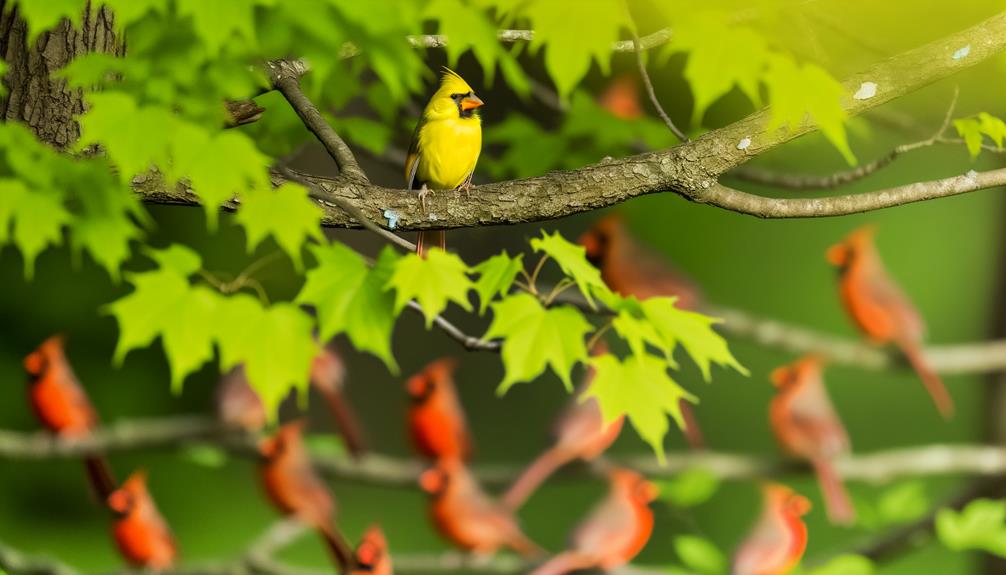Are There Yellow Cardinals in Ohio? Yes!
Yes, yellow cardinals do occur in Ohio, although they are extraordinarily rare. These striking birds result from specific genetic mutations affecting pigmentation pathways, leading to their unique yellow plumage instead of the typical red.
Despite their unusual color, yellow cardinals retain the same body shape and behaviors as their red counterparts. Sightings are infrequent, mainly reported in wooded areas and backyards.
Bird enthusiasts and ornithologists value these rare sightings highly, contributing to citizen science and research. Those interested might explore more about the genetic factors influencing this fascinating avian phenomenon.

Key Takeaways
- Yellow cardinals are extraordinarily rare color variants of northern cardinals in Ohio.
- They result from genetic mutations affecting pigmentation, specifically melanin and carotenoid pathways.
- Only a few confirmed sightings of yellow cardinals have been reported in Ohio.
- These unique birds retain the typical body shape and behavior of northern cardinals.
- Yellow cardinals captivate birdwatchers and contribute valuable data to citizen science and ornithological research.
What Are Yellow Cardinals?

Yellow cardinals are rare color variants of the northern cardinal (Cardinalis cardinalis), characterized by their striking yellow plumage instead of the typical red. These unique birds exhibit a vibrant yellow coloration, which sets them apart from their more common crimson counterparts.
The yellow hue results from a specific alteration in their pigmentation process, affecting the deposition of carotenoid pigments in their feathers. Observers note that yellow cardinals retain the same body shape, size, and behavioral traits as red cardinals, including their distinctive crested heads and melodic songs.
While sightings are infrequent, their unexpected appearance captivates bird enthusiasts and ornithologists alike. These rare embodiments of avian diversity highlight nature’s unpredictability and the endless variations within a single species.
Genetic Mutations Explained
Genetic mutations play a significant role in the color variation observed in yellow cardinals. These rare genetic traits alter the bird’s pigmentation, leading to the distinctive yellow hue instead of the typical red.
Researchers focus on understanding how specific mutations impact melanin and carotenoid pathways to elucidate this phenomenon.
Color Variation Causes
Understanding the color variation in cardinals, specifically the rare yellow cardinal in Ohio, hinges on exploring the genetic mutations responsible for this phenomenon. Genetic mutations can alter the pigments in a cardinal’s feathers, leading to rare and vibrant color variations. The primary pigments involved are carotenoids, which typically produce red and orange hues. However, mutations can disrupt the normal metabolic pathways of these pigments, resulting in a yellow coloration.
| Mutation Type | Affected Pigment | Resulting Color |
|---|---|---|
| Carotenoid Alteration | Reduced Red Pigment | Yellow |
| Melanin Deficiency | Lack of Dark Pigment | Pale Yellow |
| Enzyme Deficiency | Incomplete Conversion | Bright Yellow |
Such genetic variations are rare and fascinating, showcasing nature’s unpredictability and diversity.
Rare Genetic Traits
Mutations in the genes responsible for pigment production can lead to highly unusual and striking color variations in cardinals, such as the rare yellow cardinal observed in Ohio. These genetic mutations often affect the carotenoid pathways, altering the typical red pigmentation.
Specifically, an enzyme called cytochrome P450 is pivotal for converting dietary pigments into red hues. When mutations occur in the genes encoding this enzyme, the conversion process disrupts, resulting in yellow plumage instead of the usual red.
This rare yellow phenotype doesn’t affect the bird’s health but makes it a unique sight for birdwatchers. Genetic mutations like these exemplify nature’s variability, providing scientists and enthusiasts a glimpse into the intricate mechanisms underlying avian coloration.
Sightings in Ohio

Numerous birdwatchers in Ohio have reported rare sightings of yellow cardinals, a striking deviation from their typical red plumage. These sightings mainly occur in wooded areas and suburban backyards. Observers note that the yellow cardinal retains the same body shape, size, and signature crest as its red counterpart, making identification straightforward despite the color anomaly.
Documented instances often include detailed photographs and precise location data, contributing to a growing body of citizen science. The frequency of these sightings remains low, emphasizing the rarity of this genetic variation. Enthusiasts and ornithologists alike are captivated by each new encounter, fostering a heightened sense of exploration and wonder in Ohio’s vibrant birdwatching community.
Causes of Yellow Plumage
The appearance of yellow cardinals in Ohio, while rare, can be credited to genetic mutations impacting pigment production in their feathers. These mutations disrupt the synthesis of carotenoids, the pigments that usually produce red and orange hues.
Specifically, a condition known as xanthochroism can cause the red pigments to be substituted by yellow ones. This genetic anomaly doesn’t harm the bird but results in a remarkably different plumage.
Environmental factors, such as diet, also play a role; if the bird consumes a diet deficient in certain pigments, it can manifest in altered feather coloration.
Essentially, the yellow cardinal’s unique hue is a captivating interplay of genetics and environmental influences, showcasing nature’s unpredictable beauty.
How Rare Are They?

Yellow cardinals in Ohio are extraordinarily rare, with only a handful of confirmed sightings reported over the years. The rarity stems from a genetic mutation that alters the typical red pigmentation to yellow, a phenomenon known as xanthochroism. This mutation doesn’t occur frequently, making yellow cardinals a prized find for ornithologists and bird enthusiasts alike.
- Genetic Mutation: Xanthochroism causes the unusual yellow coloration.
- Confirmed Sightings: Only a few verified reports exist in Ohio.
- Scientific Interest: High value for research and study.
- Birdwatching Treasure: A coveted sight for birdwatchers.
Given their scarcity, spotting a yellow cardinal in Ohio is an exceptional event, underscoring the uniqueness and beauty of these rare avian gems.
Birdwatching Tips
To maximize chances of spotting yellow cardinals in Ohio, birdwatchers should focus on early morning hours when birds are most active.
Utilizing binoculars with at least 8x magnification and a field guide specific to Ohio’s avian species will enhance identification accuracy.
Key locations include wooded areas and bird feeders in suburban gardens, where these rare sightings are more probable.
Optimal Viewing Times
Taking advantage of the early morning light, birdwatchers will find that yellow cardinals are most active just after dawn. This is when they engage in feeding and vocalization, making them easier to spot and hear.
Observing during this period allows one to witness their natural behaviors undisturbed by the day’s activities. Twilight also offers a secondary peak in activity, providing another prime opportunity for sightings.
To maximize the birdwatching experience:
- Arrive early: Be at the location before sunrise.
- Stay quiet: Minimize noise to avoid startling the birds.
- Use natural cover: Blend in with the environment to observe without interference.
- Bring patience: Birdwatching requires time and stillness for the best results.
These tips will enhance the chances of encountering yellow cardinals in their natural habitat.
Equipment and Locations
With the best viewing times in mind, birdwatchers should equip themselves with high-quality binoculars and consider visiting locations known for frequent yellow cardinal sightings, such as state parks and wildlife reserves in Ohio. Binoculars with at least 8x magnification and a wide field of view are ideal for spotting these elusive birds.
Notable areas include Shawnee State Park, Magee Marsh Wildlife Area, and Killdeer Plains Wildlife Area. These locations offer diverse habitats that increase the likelihood of encountering a yellow cardinal. Birdwatchers should also carry field guides for quick identification and a camera with a telephoto lens to capture sightings.
Patience and persistent observation are key; these vibrant birds can be rare but immensely rewarding to spot.
Ohio’s Bird Habitat

Ohio’s bird habitat is characterized by various ecosystems ranging from marshes to broadleaf forests, providing an ideal environment for different avian species, including the rare yellow cardinal. These habitats support a rich biodiversity, offering plenty of food sources and nesting sites.
Marshes are abundant with insects and aquatic plants, serving as home to waterfowl and wading birds. Broadleaf forests, on the other hand, provide shelter and diverse diet options for songbirds, woodpeckers, and raptors. Prairies attract sparrows, finches, and meadowlarks, while urban areas become thriving grounds for adaptable species like pigeons and robins.
This ecological diversity guarantees that bird enthusiasts can observe a wide range of species throughout the year. Ohio’s dedication to conserving these habitats further enhances its appeal as a bird-watching destination.
Reporting a Sighting
Birdwatchers in Ohio who spot a rare yellow cardinal should promptly report their sighting to local birding organizations for documentation and study. Accurate reporting guarantees these sightings are logged and analyzed by ornithologists.
Observers should note the location, time, and any distinctive behaviors of the yellow cardinal. Submitting photographs can greatly assist in verifying the sighting. Platforms like eBird and local Audubon societies provide easy ways to report findings.
This contributes to broader research efforts, aiding in understanding the frequency and distribution of yellow cardinals. By reporting sightings, birdwatchers play an essential role in scientific research, fostering a deeper appreciation and knowledge of Ohio’s unique avian biodiversity.
Conclusion
Yellow cardinals are an extraordinary rarity, with experts estimating only 10 to 15 such birds exist at any given time. This genetic anomaly, caused by a mutation that affects the bird’s pigmentation, captivates both scientists and birdwatchers.
Ohio’s rich bird habitat offers a unique opportunity to spot these avian marvels. If you’re fortunate enough to encounter one, reporting the sighting to local birding organizations can contribute valuable data to ongoing research and conservation efforts.






